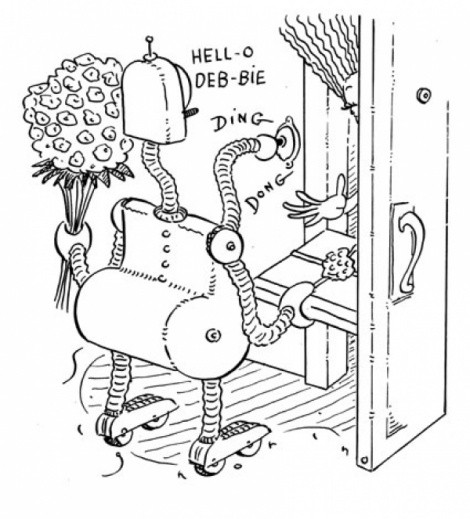Anything is possible, Debbie. The question is whether it’s likely. My guess: no. Here’s why.
What’s the point? We’ve already got a proven method of making self-propelled homunculi that realistically simulate a mature human being. It’s called sex. Five minutes of mixing the ingredients, nine months of patient construction, and 10 years parked in front of the TV. Voila, the cutest little robot you can imagine.
Does it walk? You bet. Does it talk? Like a champ. Does it think? Let’s not expect miracles. You also have the problem of having to feed it Happy Meals on a regular basis rather than storing it on the recharging stand till next needed. Nonetheless, it’s hard to imagine why you’d spend 90 jillion dollars replicating what you’ve got a globe full of bipeds churning out at their own expense.
I’m not claiming there’s no need for robots. However, the goal of commercial robotics is to produce machines capable of reliably performing a tiny subset of human functions without needing bathroom breaks or asking for a raise. These special-purpose devices, ranging from assembly-line welders to carpet sweepers, bear little or no resemblance to the living workers they replace. That’s just as well, because to the extent that they do:
It’s creepy. Let’s set aside for the moment whether we’ll ever see general-purpose positronic robots like the ones in Isaac Asimov’s sci-fi novels. An entrepreneur might well see a market for a machine that duplicated the appearance of a human for use as a product demonstrator, say, or—let’s be blunt—a sexbot. But be honest: Would you really want to deal with one?
Here we run into what Japanese robotics engineer Masahiro Mori called the “uncanny valley.” People respond positively when inanimate objects are endowed with human characteristics—up to a point. But if the object begins to approximate humanness too closely without getting all the way there, affection gives way to revulsion. That’s the valley on the emotional-response chart.
Movie animators stray into the uncanny valley at their peril. The success of Pixar productions like the Toy Story series, A Bug’s Life, etc, suggests we’re delighted by animated creations that are recognizably caricatures. But many blame the chilly response to Final Fantasy: The Spirits Within and The Polar Express on the fact that the human characters in these films were too lifelike to be endearing but not lifelike enough to seem real.
An android presents the same problem. If you’re going to go to the trouble of creating a human-seeming cable-guy-bot, you don’t want to find you’ve succeeded just enough to freak the customers out.
Finally, let’s not minimize a fundamental problem:
Making a good android is really tough. A convincingly human robot needs to do two things. First, walk the walk, which is to say, closely reproduce not just human appearance but human movement, and second, talk the talk, meaning not just that it sounds like a person but that it interacts with its environment as we do.
The purely mechanical part is plenty difficult. Honda engineers have been working on robots capable of walking since 1986; one early model incorporated a computer, 32 motors, a battery, a radio, and numerous sensors and weighed 462 pounds. The current model, called ASIMO, has been slimmed down to 95 pounds and can walk in a circle (no mean feat) and ... well, the engineers call it “running,” but top speed is less than four mph, which is more like a slow jog. If you’re looking for a droid that can do the hokey-pokey, that could be a ways down the road.
But realistic movement is just the start. The bigger challenge is getting the robot to behave like a human. The classic standard here is the Turing test, discussed in this column in the past: whether a machine’s conversational responses can be distinguished from those of a person. Some big heads in the world of artificial intelligence have spent decades arguing whether a machine that passed the Turing test would be truly thinking, but all we need for our purposes is a convincing fake. Even optimists doubt we’ll reach that modest goal before 2029.
Despite the difficulties, buffs claim more lifelike robots would be better adapted to the human environment than the primitive devices we have now. I’m not entirely buying this—experience suggests it’s generally simpler to redesign the environment than the machine. (Example: other than buildings, arguably the most sustained capital investment in history has been in flat rolling surfaces for wheeled vehicles.) Still, progress being what it is, maybe someday we really will have mechanical maids like in the old Jetsons cartoon. But androids that can persuade you they’re human, or close to it? I won’t say never. But not soon.
Send questions to Cecil via StraightDope.com or write him c/o Chicago Reader, 11 E. Illinois, Chicago 60611. Subscribe to the Straight Dope podcast at the iTunes Store.
